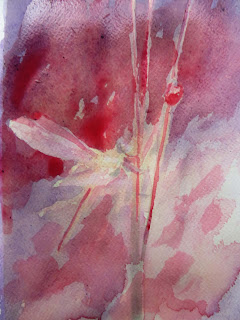A good way to bleed colours into one another is through "blooming". Take a good amount of water to pigment in your brush and apply it to the paper. When the stroke is still wet, add in another colour with similar amount of water. You can manipulate the colours to where they need to be at this point. Allow this to dry and you'll notice that there are subtle gradients throughout the application
This is a try out of technique with the following result:
(Main steps are indicated below)
Step 1 "Note.As this is one of my first try-outs with this technique, "I still have to make more improvements " -, -- (Watercolour is about planning. Think about where you'd like your whites and lights before you apply paint. It's vital to keep control of your brush as you paint in the edge of where you'd like your negative space to begin)
1.1.- So I sketched directly with a round brush with a yelowish tone above the still dry paper, letting it dry throughly before next steps
1.2.- with a wet sponge I damped the paper where I wanted to add the violet color (with a big round brush) as background
Where the paper is not wet, the color won´t spread
Note.- paper is Fabriano 140 lbs
One very important tool to have in your tool kit when working with watercolours is a paper towel. The paper towel almost acts as a kneaded eraser for your watercolours. Laying down a wash of colour and then lifting parts of it up is a great way to add layers of detail gradually. Paper towels are also very useful for correcting mistakes or directing the paint in different direction
Another way to cause watercolor blooms is to put a very wet wash of color across your painting surface. Tilt the surface slightly or even more drastically. Allow this wash to dry. Notice that the color has drifted to the bottom of the page, and when it had nowhere else to go, it started floating upward again….thereby causing another type of Bloom.
if you allow your wet paper to lose its shine, the addition of more color will not cause a bloom
As I apply more color, I'm careful to keep adding water so the colours blend and stay soft. It can be easy to overwork and produce a muddy look, so less is more.
Sometimes you'll need to "erase" your watercolour. While you can't return the paper to 100% white, you can lift away colour to correct a mistake or adjust the lighting in a piece. Work with an already dry swatch of watercolour and using clear water, paint in the shape you'd like to lift out. Let it set for a just a minute then dab away the water with a paper towel. You'll see the colour lift out in the shape you painted in
Using my paper towel, I begin to lay in colour and take it away to get a more layered look to my piece. I am careful to let areas dry before I apply more color but now with a big round brush and lot of red pigment on it. This allows me to move around the whole study. I'm also paying more attention to what colour goes where. – light to dark, wet and dry, as well as colour pulling – to achieve the look I'm wanting. for details I´m using orange and dark blue
Bonus Painting
Same technic but colors are more different between them therefore additional contrast (complementary colors Works pretty good for shadowing)
"Searching in the Dark Woods"
Ref 1157
Please wait; wait; WAIT !










































